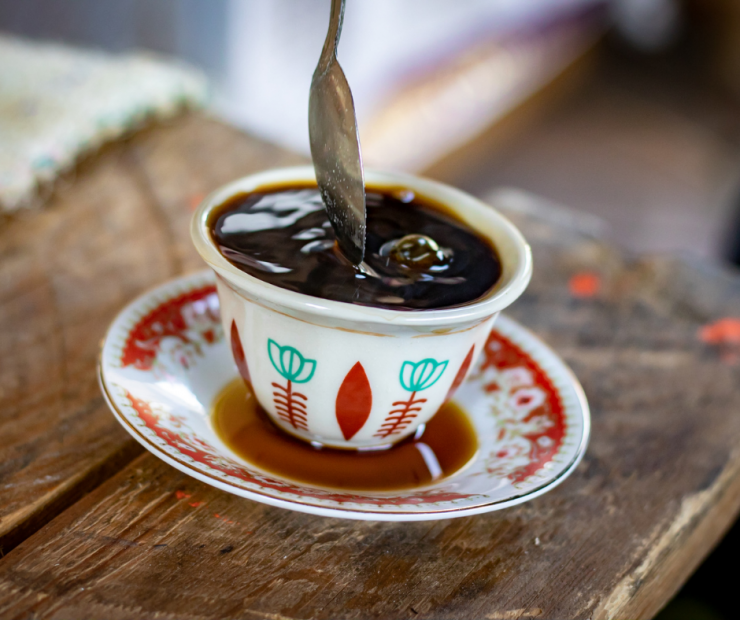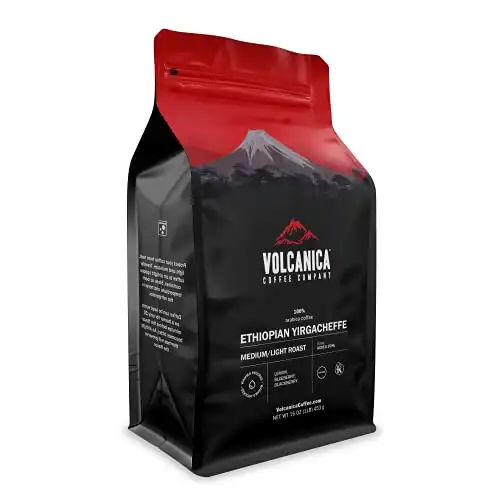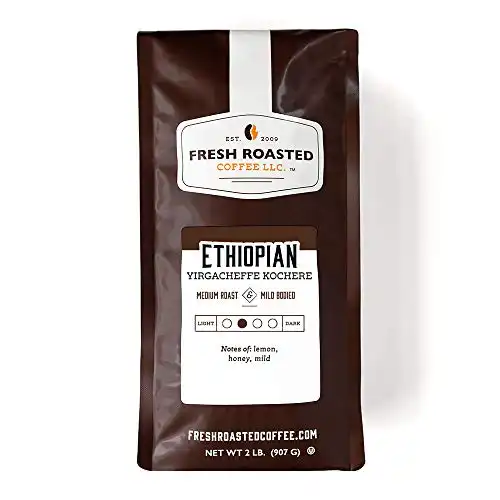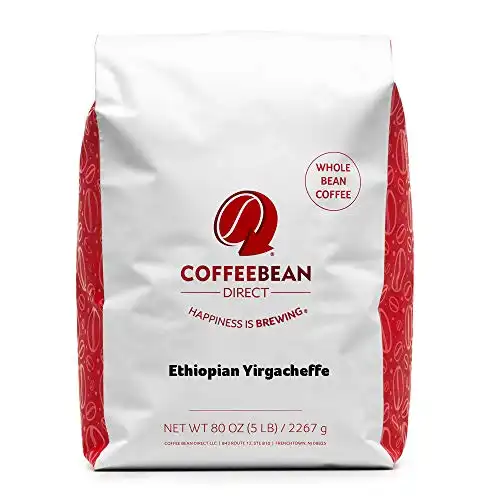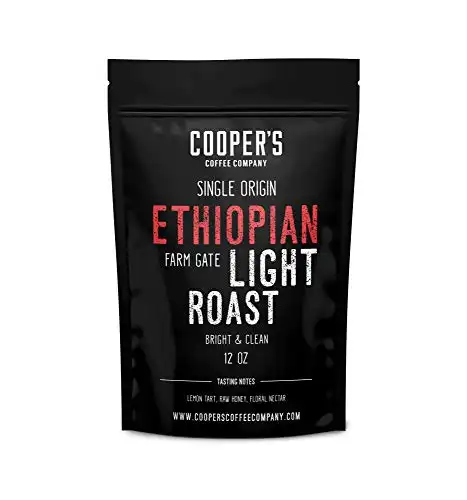- The World’s Second Most Traded Product
- Ethiopia: The Birthplace of Coffee
- Ethiopian Coffee Flavor Profile
- Ethiopian Coffee Growing Regions
- Quick Glance: Our Top 5 Picks for Ethiopian Coffee
- Ethiopian Coffee: Top 5 Picks
- Best Ethiopian Coffee
- 1. Volcanica Ethiopian Coffee Yirgacheffe Whole Bean
- 2. Wild Coffee Austin Roasted Organic Sidamo
- 3. illy Ethiopia Single Origin Whole Bean Coffee
- 4. Fresh Roasted Coffee LLC Ethiopian Yirgacheffe Kochere Whole Bean Coffee
- 5. CoffeeBean Direct Dark Ethiopian Yirgacheffe
- 6. Coopers Coffee Company Ethiopian Single Origin Light Roast
- Ethiopian Coffee Facts
- The Ethiopian Coffee Ceremony
- Brewing Techniques for Ethiopian Coffee
- How to Roast Ethiopian Coffee
- Final Word
I’d like to tell you a story about Ethiopian coffee.
But before that, let’s look at some solid facts about this larger-than-life commodity. These facts will go a long way to prove that your love for coffee isn’t misplaced.
Stay with me.
With a café at literally every corner of most cities in the world, coffee is undeniably one of the world’s top commodities.
We want you to know this post contains affiliate links. If you click on a product and decide to buy it we may earn a small commission at no extra cost to you.
The World’s Second Most Traded Product
As the world’s third most consumed drink, after water and tea, the demand for coffee beans isn’t going anywhere.
Each of the coffee-producing nations provides coffee beans in millions of kilograms that eventually reach out to the hands of enthusiastic consumers.
After crude oil, coffee is the second most traded product in the world, with approximately 2.25 billion cups consumed yearly.
Sure, we brew a tasty cup ‘o Joe from coffee beans. But that’s not all that these precious beans do.
Through decaffeination, coffee beans are a source of caffeine for other beverages, such as cola.

The Cradle of Arabica Coffee
There are two major types of commercial coffee beans. The first one is Arabica, which comprises 70% of all coffee in the world.
There’s a strong chance it’s the coffee in your kitchen cabinet right now.
We also have Robusta, which is much easier and inexpensive to grow.
Keep reading.
Ethiopia is the cradle of Arabica coffee – the world’s most popular beans. In 2019, alone, Ethiopia exported 384,000 metric tons of coffee.
Ethiopia ranks fifth in the world’s top coffee producers. Not to mention, it’s the top producer of coffee in Africa.
Still with me?
Now, let’s move on to the thrilling story of the origin of coffee.
Ethiopia: The Birthplace of Coffee
Abyssinia (current Ethiopia), is regarded as the origin of coffee. It’s based on an ancient but exciting story that goes like this…
Approximately 12 centuries ago (around 850), a goat herder known as Kaldi was tending to his goats. Suddenly, he noticed that some of the goats began bleating with more vigour and energy after consuming mysterious red cherries.
His wife instructed him to take the berries to a monastery close to Lake Tana.
What follows will shock you…
After arriving at the monastery, Kaldi handed over the berries to one of the monks. The monk tried one of the berries and ecstatically exclaimed the berries’ impact on his body and thoughts.
Next, Kaldi stretched out his hand containing the berries, which the monk grabbed and threw them inside the fire, referring to them as the “devil’s work.”
Here’s what happened next…
Within a few minutes, the sweet smell of roasting coffee enveloped the chamber, prompting other monks to start finding out what triggered the heavenly aroma.
You won’t believe how the story ends:
Excited, the curious monks removed the coffee beans from the fire, crushing them. The head monk asked for water to be poured over the powdered coffee.
After drinking the concoction, the monks stayed up the entire night, vowing to always consume it so they can keep alert for their nocturnal devotions.
That’s how the monks tried the first brew, which gave birth to the coffee drinking art. Soon, everyone knew about this event and within days, everyone was drinking coffee all over the country.
In 1454, the Mufti of Aden visited Ethiopia and sampled the coffee drink. He claimed that the beverage had cured him some illness.
His men took the claims seriously and spread the word. Soon, coffee was introduced in Mecca and Yemen where it featured on the menu in every eatery.
Since the coffee discovery, it has gradually become Ethiopia’s biggest export. This has remained despite major government transitions and social transformation. To date, coffee accounts for 60% of Ethiopia’s exports.
So, did coffee originate in Ethiopia? Yep, Kaffa, an area in southwestern Ethiopia is the coffee plant’s origin.
The initial coffee discovery was in Kafa Biosphere Reserve, which is found in Ethiopia’s Kafa Zone. Unlike other coffee-growing countries, coffee trees are known to grow naturally in Kaffa.
Currently, the area comprises approximately 5,000 varieties of Arabica coffee.
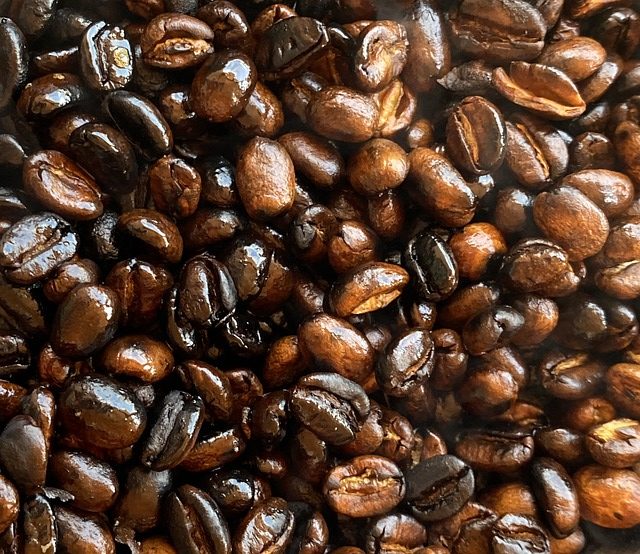
Ethiopian Coffee Flavor Profile
The Ethiopian coffee beans are known for their bright mouth feels and wine quality.
The coffee has a combination of floral and bright fruited flavor. Often, the coffee has a light to medium body, higher acidity, and complex flavor notes.
The coffee beans may be washed or undergo natural processing. How they are processed hugely affects the coffee’s final flavor.
Here’s how the processing method affects the taste:
Wet Processing
When the coffee beans are washed or wet-processed, the fruit is mechanically removed. The beans have a flavor clarity with bright and complex notes.
Washed beans typically showcase lemongrass or jasmine characteristics. Their taste is drier and lighter. In a nutshell, the final drink is clean tasting.
Natural Processing
On the other hand, naturally processed coffee undergoes drying with the fruit still intact on the bean. The fruit pulp won’t be removed until the coffee is about to be exported.
Naturally processed coffee has winey or fruity tones, along with complex blueberry tones. Additionally, it features a medium to heavy body with a dry edge.
Fruited notes, such as blueberry, dominate these beans. The beans also consist of deep chocolate undertones as well as a syrupy body.
Ethiopia processes most of its coffee naturally and has been doing so for centuries. What’s a bit new is the wet processing, which continues to change with the introduction of new equipment.
Ethiopian Coffee Growing Regions
When looking for top-tier Ethiopian coffee, it’s essential to know the areas that produce various types.
Ethiopia has three major regions where coffee production occurs. They include Yirgacheffe, Sidamo, and Harrar. Each region produces coffee whose flavor is unique to the area.
Let’s look at what to expect from each region:
1. Sidamo
Sidamo (or Sidama – while the former refers to the area that used to be called Sidamo province, the latter refers to the Sidama people) is Ethiopia’s southern province and is where you’ll find most of the coffee-growing spots.
Sidamo is a large area that spreads through Lake Awasa’s fertile highlands in the Rift Valley. It consists of 20 administrative regions with diverse altitudes and microclimates.
Sidamo has excellent climate conditions for coffee growth, thanks to its altitudes that range from 1,500 meters to 2,200 meters above sea level.
On top of that, the region enjoys ample rainfall, fertile soil, and optimum growing temperatures.
Approximately 60% of Sidamo coffee is washed, but Sidamo is also known to produce high-quality sun-dried coffee.
This region has about 50 cooperatives and other numerous private buying stations. There are more than 200 washing stations throughout the 20 administrative districts.
Thousands of coffee bags with the Sidamo label are sold each year, but they all vary in cup quality.
Generally, Sidamo coffee has a rich body with mild acidity and a floral and citrus aroma.
2. Yirgacheffe
Yirgacheff is found in the Sidamo region. So, why can’t we generalize its coffee with that from Sidamo?
Its exquisite washed coffee is so popular that it’s recognized as a unique coffee-producing region.
As a matter of fact, the Ethiopian government has trademarked it as a separate micro-region.
The steep, green region has a high altitude, where coffee grows at least 2,000 meters.
Yirgacheff is fertile enough to provide adequate nutrients for coffee growth.
At first glance, you might think Yirgacheffe is a thickly forested area without many people.
But, nothing could be further from the truth: this area is densely populated and the hills have numerous homes and villages that grow ‘Garden Coffee.’
Yirgacheffe has about 26 cooperatives that represent at least 44,000 farmers and approximately 62,000 hectares of coffee trees.
The coffee here is mostly washed, but a small percentage is sundried.
The resulting drink is highly acidic, bright, and light-bodied. The taste is sweet, fruity with floral notes.
3. Harrar
Located towards the east of the country’s capital city – Addis Ababa, Harrar mostly produces dry-processed coffee.
In the nineteenth century, coffee from Harrar was praised for being of higher quality than other coffee grades, Abyssinia – wild-grown coffee produced from other parts of the country.
Even to this day, Harrar’s coffee is known for its highest quality and everyone loves it.
Now, this is important.
Nowadays, Harrar coffee primarily originates from wild native coffee trees found on small pieces of land within the country’s eastern part.
After harvest, the coffee undergoes dry processing after which it’s traditionally classified as shortberry (smaller), longberry (large), or Mocha (peaberry).
Harrar coffees have varied flavors; they range from blueberry to many other flavors, including strawberry, banana, bubblegum, and minty.
Honorable Mentions
Sidamo, Yirgacheffe, and Harrar Ethiopia’s top coffee-growing areas. But we also have other smaller areas that produce high-quality coffee. These are:
4. Guji
Guji is found in the southern part of Sidamo. This coffee zone was formed in 2002 and derived its name from an Oromia tribe.
Coffee from Guji has a distinctive flavor that sets it apart from other areas. No wonder, some of the world’s top roasters only prefer coffee from Guji.
Flavor notes are floral, dark chocolate, but with sweetly tart acidity.
5. Limu
Limu is another area to find excellent coffee. Located in Ethiopia’s southwest region, Limu coffee grows at an elevated area of between 1,100 and 1,900 meters above the sea level.
It’s popular for its tasty cup, winey, spicy, and sweet flavor in addition to the balanced body.
Limu coffee is among Ethiopia’s excellent highland-grown coffees.
Even the bean’s appearance tells you it’s fantastic: it’s medium-sized, has a unique round shape, and green in color.
So, now that we know where the best Ethiopian comes from, where can you get some of this coffee and enjoy the goodness?
If you’re in a hurry, you can quickly check out our top picks below:
Quick Glance: Our Top 5 Picks for Ethiopian Coffee
1. Volcanica Ethiopian Coffee Yirgacheffe Whole Bean
2. Wild Coffee Austin Roasted Organic Sidamo
3. illy Ethiopia Single Origin Whole Bean Coffee
4. Fresh Roasted Coffee LLC Ethiopian Yirgacheffe Kochere Whole Bean Coffee
5. CoffeeBean Direct Dark Ethiopian Yirgacheffe
Ethiopian Coffee: Top 5 Picks
Volcanica Ethiopian Coffee Yirgacheffe Whole Bean |
| ||
Wild Coffee Austin Roasted Organic Sidamo |
| ||
illy Ethiopia Single Origin Whole Bean Coffee |
| ||
Fresh Roasted Coffee LLC Ethiopian Yirgacheffe Kochere |
| ||
CoffeeBean Direct Dark Ethiopian Yirgacheffe |
|
Best Ethiopian Coffee
Want a little more info to help you find and start brewing the best Ethiopian coffee in your kitchen?
Let’s get this show to the road.
1. Volcanica Ethiopian Coffee Yirgacheffe Whole Bean
Want to wake up to great exotic coffee? Don’t we all?
Well, Volcanica Yirgacheffe Coffee won’t disappoint.
So, why should you care about this Ethiopian coffee?
Well, first, it’s responsibly sourced. Volcanica works directly with Ethiopian coffee farmers and local cooperatives. The company has spent years building relationships with coffee importers.
This can only mean one thing: the coffee sourced is of the highest quality.
Volcanica Yirgacheffe Coffee is freshly roasted because the company roasts coffee beans on demand. Next, the coffee quickly undergoes packing and sealing to enhance freshness.
Brewing freshly roasted coffee means nothing will tamper with the sweet fruity and floral flavor coupled with blueberry, lemon, and blackberry notes.
And speaking of flavor, these organically grown light/medium roast whole beans produce an authentic flavor that leaves you wanting more.
That’s not all though.
Volcanica has SCA-trained roast masters who understand the delicacies and nuances involved in roasting the Yirgacheffe whole beans.
And you know when coffee undergoes perfect and professional roasting, you can feel the difference in every sip.
You might be wondering, how’s Volcanica Yirgacheffe Coffee processed? It’s through wet processing, which leaves you with a clean, complex, and floral cup – just what you need to energize those dull mornings.
Did I mention it’s caffeinated too?
Oh, and the PH of this coffee is 5.1. In other words, the acidity is pleasant rather than sharp and bitter.
You can enjoy it black or with milk and it won’t lose its distinct flavor. Try this great coffee with your favorite brewing style and you might just get addicted!
2. Wild Coffee Austin Roasted Organic Sidamo
What comes into your mind when you hear the word ‘wild’?
Something natural and organic, right?
As the name suggests, Wild Coffee Sidamo is organic and comes from single-origin. Wild Foods expertly sources the beans from small-scale farmers known to produce the world’s highest-quality coffee.
Wild Coffee is roasted in Austin, TX and hand-delivered to Wild Foods every week. Not keeping large stocks is beneficial to customers, who only receive freshly-roasted coffee to enjoy the natural taste of Sidamo coffee.
Wild Coffee Organic Sidamo is among the coffees you can brew whichever way you want and it retains its delicious taste.
That said, you can use pour over, Aeropress, French press, or even cold brew to brew your cup.
Go beyond brewing coffee and use Wild Sidamo Coffee to make tasty smoothies, protein shakes, and butter coffee drinks. The versatility is one of the reasons this coffee has legions of fans.
This Fair Trade, Single Origin, and USDA Organic coffee is one of the purest coffees you’ll ever enjoy. Lack of toxins and other additives mean you enjoy the natural flavor of the Sidamo medium roast whole bean.
To make it even better, grind the beans just before you’re ready to brew and you’ll feel the difference between fresh, tasty coffee and the average coffee that overstays on the supermarket shelves.
This brand stands behind their product with a 100% guarantee, which speaks of the premium quality of this coffee.
3. illy Ethiopia Single Origin Whole Bean Coffee
illy Ethiopia is one of the world’s finest coffees.
And here’s why:
The coffee is sourced from Yirgacheffe where it grows in rich soil and is hand-picked in small home gardens or plantations.
Each sip of the Illy MonoArabica coffee takes your imagination to the very birthplace of coffee.
You’ll experience the heavenly aroma that triggered those monks to remove the berries from the fire and crush them into something delicious.
The single-origin Arabica coffee highlights the singular culture, style, and taste of the unique Yirgacheffe region.
Sipping illy Coffee is a perfect way to satisfy your curiosity and awaken the senses and yet get a pleasurable escape from your ordinary setting.
The 100% Arabica Coffee has a bold but not bitter flavor with chocolatey tones that linger in the mouth.
The light roast whole beans come in 8.8oz cans and are affordable as well.
If you’re looking for flavorsome, light and bright coffee with subtle flavors, we recommend the illy Ethiopia Coffee.
4. Fresh Roasted Coffee LLC Ethiopian Yirgacheffe Kochere Whole Bean Coffee
The Kochere Whole Bean is perfect for everyone.
Here’s something you probably didn’t know about this coffee’s origin:
Kochere is a small district within the popular Yirgacheffe coffee-growing region.
Kochere has communal washing stations where local farmers go to process their coffee following harvest.
Here’s an interesting fact about Kochere:
It’s renowned for producing top-tier Ethiopian coffee beans grown on nutrient-rich soil at high altitudes that have pleasant acidity.
Fresh Roasted Coffee LLC procures this coffee with the utmost integrity and care so they can find top-grade coffee that reinforces their core value of sustainability.
While doing this, they help small farmers to support their livelihoods.
The brand uses advanced technology to roast the beans. They use a smokeless coffee roasting system that has, so far, eliminating their carbon footprint by up to 80%.
Not only does their Loring Smart Roaster (made in the USA) reduce carbon emissions; it also boosts the overall bean flavor, roasting precision, and quality.
Amazing, isn’t it?
If you fancy freshness, this coffee delivers just that. The company freshly roasts the beans followed by immediate packaging to preserve the freshness.
They also do something else:
To ensure the coffee remains fresh for the longest time possible, Fresh Roasted Coffee fills single-serve pods with nitrogen insufflation to minimize exposure of freshly ground coffee to air that might ruin its flavor.
So, how does a cup of Kochere Coffee taste?
It’s a medium roast with a floral body and a predominant lemon flavor. The resulting cup is not only balanced and well rounded, but it’s also less acidic.
5. CoffeeBean Direct Dark Ethiopian Yirgacheffe
CoffeeBean Direct Dark Ethiopian Yirgacheffe and is rich with no bitter finish.
It’s a single-origin coffee that is surprisingly smooth while still being bold. It has fruity, wine and floral notes with a delicious chocolatey finish.
These beans work well with drip coffee makers, pour-over, French press and AeroPress.
We love using our favorite French press to brew with these beans and then adding some half and half or whipping cream. AMAZING!
CoffeeBean Direct is passionate about coffee and committed to providing fresh and fairly priced products.
Their roasterie is independently owned and operated out of Frenchtown, New Jersey. This means they’re able to control each part of fulfillment - every bag is hand-packed.
CoffeeBean Direct sources its coffee from different parts of the world, including Costa Rica, Brazil, Kenya, Sumatra, and elsewhere, to find flavor-rich beans that will put a smile on your face with each sip.
6. Coopers Coffee Company Ethiopian Single Origin Light Roast
This coffee features vibrant aromas with a colorful flavor. The coffee beans acquire this unique flavor because of the drying process involved on the farm.
It involves laying out the heirloom coffee cherries on raised beds so they can dry in the sun.
This drying process results in unique citrus, wild berry, and raw floral honey tones and the light roast delivers intense and bright flavor to your cup.
The company carefully sorts their beans and doesn't use those that fall short of their high standards.
The roasting occurs in small batches to deliver maximum freshness.
What about the coffee’s acidity?
Well, it’s flawless; the lemon citrusy taste isn’t harsh, but it’s crisp and clear.
The aftertaste is equally refreshing; it has hints of lemon and doesn’t coat or linger on your tongue.
Cooper’s is committed to finding the best single-origin coffee beans - grade 1 only and keeps testing and improving their roast profiles, making this one of the best Ethiopian coffees on the market.
Ethiopian Coffee Facts
- Ethiopia is the origin of coffee. There is a story to it. A goat herder known as Kaldi discovered the beans when his goats reacted strangely after they ate them.
- Ethiopian coffee is grown in alpine areas that are 5000-7200 feet above sea level. The main coffee-producing areas are Harrar, Yirgacheffe, Sidamo, and Limu.
- In Ethiopia, both dry and wet methods of processing the coffee plant are used. Dry processing involves the cherries being dried immediately after harvesting is done. Wet processing entails first pulping and fermentation of the cherries harvested. Then after removing the mucilage cover, the beans are washed before being dried in the sun. Both methods are effective in producing high-quality coffee beans.
- Coffee in Ethiopia carries an immense significance in their culture. A daily event known as the Ethiopian coffee ceremony is in place to ensure this tradition is never forgotten. During the event, people take the time to socialize and bond with one another.
- Ethiopia is Africa's largest and the world's fifth-largest producer of coffee. Ethiopian coffee accounts for 4.2% of worldwide coffee production. 50% of the coffee produced in Ethiopia is consumed locally and 25-30% of its revenue comes from coffee exports.
- Ethiopian coffee is served in tiny porcelain cups without handles known as sini. The method used in brewing coffee in Ethiopia produces a strong, rich, and flavorful drink. The coffee is served with sugar, and, in Ethiopia, milk is not preferred in drinking coffee.
- Three varieties of Arabica coffee in Ethiopia are registered trademark and owned by the government. The three varieties are Ethiopian Harrar, Ethiopian Yirgacheffe, and Ethiopian Sidamo.
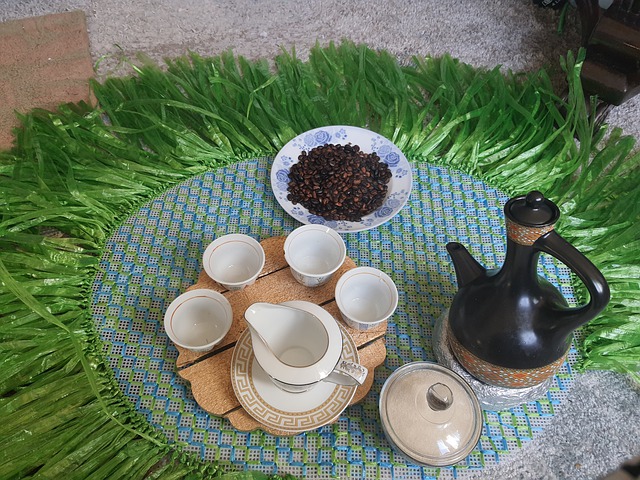
The Ethiopian Coffee Ceremony
Coffee in Ethiopia is so important to its citizens they won't mind sitting for hours enjoying it. The coffee ceremony is a perfect event to ascertain their love for coffee as a nation.
The ceremony can be held up to three times a day for 2-3 hours each time.
In many areas across the nation, the event is believed to be an important social and cultural occasion, and to be invited to one is a great symbol of friendship and respect.
In return for being sent an invite, the guest may show appreciation by offering any gift such as myrrh or sugar.
Young Ethiopian Girls Conduct the Ceremony
The honor of hosting and conducting the ceremony typically falls to young women. They wear a traditional dress, usually ankle-length, white in color, and made of cotton.
The women are usually so good at what they do they make it look simple to the eye, but the skills to produce the coffee drink are derived from years of training and experience.
Most of the younger Ethiopian girls who get to witness the ceremony several times a day are encouraged to acquire the skills through apprenticeship.
In many cases, the young girls start the journey of becoming master hostesses by serving a cup of coffee to all guests, or the guest of honor, or traditionally to the oldest guest first.
The ceremony is also a space to share past and current issues in politics, sports, and any other relevant topics.
But before an Ethiopian coffee ceremony commences, the hostess spreads an assortment of fresh flowers and grasses on the table and on the floor.
She burns frankincense filling the whole room with a pleasant aroma and warding off evil spirits. She then provides her guest's traditional snacks like cooked barley, popcorn, and peanuts.
Raw coffee seeds are first washed to separate them from the husks and debris.
Roasting
Once clean, the beans are roasted in a long-handled pan placed above an open charcoal fire. Next, the hostess roasts the beans rhythmically to prevent them from scorching on the pan.
The seeds are left to heat until they start to become darker and gleaming because of their oils. They also start making pop sounds.
At this stage, the pungent aroma of the beans has formed, and the hostess swings the pan to the guest's direction to allow them to smell and appreciate it; this is considered a crucial part of the occasion.
Grinding
After the beans are finished roasting, the hostess grinds them using a mukecha and zenezena – mortar and pestle. All the while, she had water put in a unique handcrafted pot known as jebena heating up.
The Brew
She now adds the ground coffee beans into the jebena containing simmering water and lets the contents inside boil.
After some time, the brewed coffee known as bunna is poured out of the jebena and into a decanter to allow for cooling. The cooled bunna is poured back into the jebena and boiled again. This process is repeated thrice for the coffee to be deemed ready to drink. And ready to drink it is.
Testing and Serving
Small, handleless cups called sini are arranged on a coffee platter called rekebot. The hostess pours coffee into the first cup, which is traditionally not meant for consumption but for confirming whether the murky liquid is devoid of all coffee particles.
The hostess proceeds to fill the cups to the brim without overfilling. She adds more snacks to the guests as the coffee is never drunk alone.
Coffee is always served black, but guests can sweeten it if it is their wish using sugar. At ceremonies held in country homes, salt may be preferred to sugar.
Regardless of what you choose, guests accord praises of all sorts to the hostess as they enjoy every cup.
In this ceremony, coffee is served in three rounds: abol, tona, and baraka. Every cup is weaker than the previous one. Failure to complete all three cups is thought of as impolite in Ethiopian culture.
The Ethiopians believe that your spirit fully transforms only if you consume all three cups.
Nevertheless, all guests must shun rejecting the cup of coffee, although in exceptional cases, tea may be served in place of coffee.
The third cup is said to carry a blessing to whoever drinks it; baraka literally means blessing in English. If you wish to take more cups than three, it is allowed.
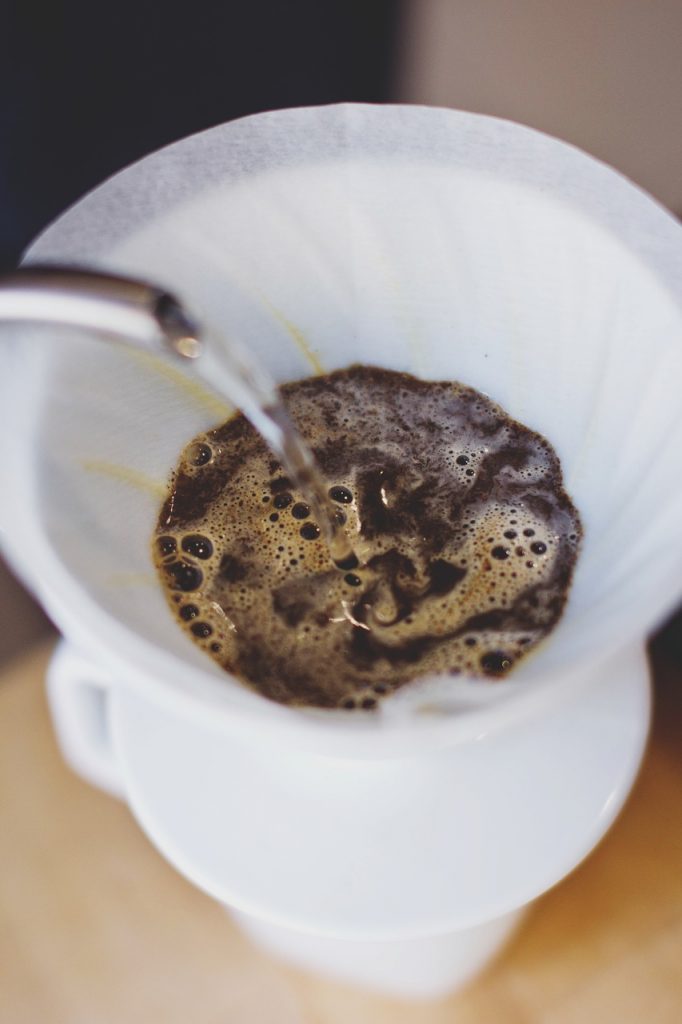
Brewing Techniques for Ethiopian Coffee
At this point, we can all agree that Ethiopian coffee is the epitome of great coffee.
All coffee enthusiasts know about Ethiopian coffee, and deservedly so. Regardless of the variety, Ethiopian coffee beans guarantee you a strong and rich brew full of delightful flavors and aromas.
However, for the coffee's pleasant flavors and aromas to remain intact until it reaches your cup, you have to get the technique of brewing it right.
Read below for the methods and techniques of brewing your Ethiopian specialty coffee.
1. Pour-Over Method
Its name suggests it. The pour-over method involves placing ground coffee in a cup and pouring hot water over them.
Gently pouring hot water over ground coffee allows the water to soak up and release the rich flavors of your Ethiopian coffee.
The pour-over method's greatest merit is the amount of control you have over the coffee you're brewing – water temperature, grind size, the ratio of coffee to water, and flow rate are factors that depend entirely on your taste and preference.
Here's how to do it:
- In the paper filter you have attached to your pour-over funnel, place 5.5 grams of Ethiopian coffee.
- Pour your 200-250°F water gently over the coffee, beginning at a high position while progressively lowering it.
- Once you fill your cup, let it sit for two minutes.
- Serve your coffee and enjoy.
2. French Press
If you're searching for simplicity and consistency in your cup of Java, have you tried out French press?
This method also offers you an economical and quick way to brew your coffee.
The French press method entails hot water and the ground coffee brewing simultaneously in the receptacle. Ensure your Ethiopian ground coffee is coarse enough to prevent them from slipping through the holes in the filter of the French press while you're pouring your brew.
This method retains all the flavors and aromas in your coffee, resulting in a strong and rich brew.
Nevertheless, you may find a little residue at the bottom of your cup as the filter may fail to separate the tinier particles from your coffee.
Here's how to do it:
- Place 7.5 grams of your Ethiopian specialty coffee into the French press.
- Pour your 200-250°F water into the French press and allow the mixture to brew for 2-3 minutes before you push down the plunger.
- Slowly push the plunger downwards at a consistent pace to the bottom of the French press. Notice how the ground coffee is packed at the bottom.
- Serve your coffee and enjoy!
3. Automatic Drip
The automatic drip method requires an automatic drip coffee maker to brew your Ethiopian specialty coffee. The machine employs the filter-drip technique of brewing coffee.
The automatic drip coffee maker depends on thermally induced pressure and gravity to push water up towards the shower head and down to the coffee grounds.
The downside to the automatic drip method is that the paper filters can trap oils that contain certain flavors resulting in a less rich brew. It also absorbs a lesser soluble mass of the coffee used.
This method is, however, effortless, uncomplicated, and affordable.
Here's how it works:
- Water is poured into the drip machine and heated by a heating element.
- The water flows to a showerhead, where it drips onto a filter filled with ground coffee absorbing all its flavors and aromas.
- The coffee is now brewed and flows through the paper filter into a carafe.
4. Cold-Brew Method
The cold brew is a subtle way to prepare and enjoy a chilled cup of Ethiopian coffee.
Preparation of coffee using the cold brew method is time-consuming but straightforward.
Expect a less acidic drink that is much smoother in taste using the cold brew method as no hot water is used.
Here's how to do it:
- Into your pitcher, add 1 part of your Ethiopian specialty coffee grounds and 4 parts of water.
- Cover the pitcher with a lid and let it sit in the fridge for 12-18 hours. Before twelve hours, the coffee won't have extracted its composition into the water, while beyond eighteen hours, the coffee may over-extract.
- It's done. Serve and enjoy.
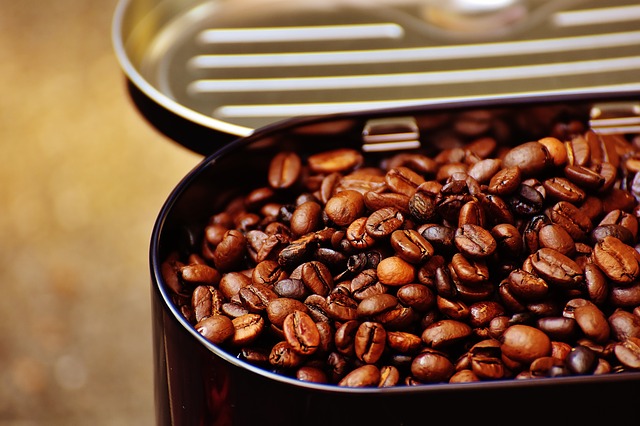
How to Roast Ethiopian Coffee
Ethiopia has more than 10,000 coffee bean varieties, including the Harrar, Jimma, Sidamo, Limu, and Yirgacheffe types.
Ethiopian coffee is best roasted by itself (not mixed with other beans) and its ideal roast is medium.
Because of the differences in screen size, high density, and unknown varieties, it’s a bit tricky to manipulate Ethiopian coffee while roasting.
To find a perfect roasting profile takes trial and error and really depends on what your taste preference is. Ethiopian coffee beans are best slow roasted because they’re small and rarely uniform in size.
If you’re using an at home coffee roaster be prepared for a learning curve.
Features that Differentiate Ethiopian Coffee Beans
Generally, Ethiopian coffees grow at high altitudes, which makes them yield dense beans high in sugars and flavor precursors.
For an effective roast profile, you have to know the bean density. This will help in determining the charge temperature and coffee flavor.
Ethiopian coffee beans are smaller than other varieties (15+ screens).
That’s why it’s tricky to roast them without them losing the delicate and nuanced flavors.
Therefore, constant monitoring of the roasting process is key to obtaining the right flavor balance.
Roasting Ethiopian Coffee
When working with Ethiopian coffee beans, you need to consider a lot of variations and roasting adjustments.
With the correct guiding principles, you can create an excellent roasting profile.
Preparing and Sampling the Beans
Ideally, there is no single uniform roast procedure for Ethiopian coffee.
The ultimate decision depends on you.
For instance, if you decide you want an espresso blend, you may have to increase the roast time.
But if you’re looking for a more subtle coffee flavor with high acidity, you’ll roast your beans at lower temperatures for a shorter time (filter roast).
Coffee that has gone through washed processing requires aggressive roasting.
Quality, simple roasting can bring out flavor profiles at different color intensities.
Temperature and Roasting Level
Through careful monitoring and a gentle temperature increase, you’ll get the best flavor out of your beans.
A light roast lets the acidity and flavors shine.
To navigate all the complexities and preserve the flavor profile of these specialty beans, start with a low temperature, then gradually increase it during the first crack.
Remember, natural coffee beans darken faster than their washed counterparts.
Things to Consider During Ethiopian Coffee Roasting
For roast levels, always keep a slow roast with medium to medium-dark roasting levels.
Make slight adjustments on the roast degree to diminish or enhance the acidity.
You can decide to do a dark roast when the flavor or aftertaste needs to be hidden.
When you are roasting your Ethiopian beans, avoid intense heat as much as you can. A strong heat pushes the clove or gingery spice notes out, and you may lose them altogether.
Intense heat on washed Ethiopian coffee beans makes them lose energy during the first crack.
This may overdevelop some of the beans while others will remain underdeveloped before the roast is dumped to achieve the right light color profile.
Doing the same with natural beans can cause a temperature spike in the coffee before the first crack, causing roast defects.
The result will be a burnt bean exterior color with an underdeveloped interior.
Roasting Ethiopian coffee is all about tailoring the roasting process and finding that distinct balancing point.
Heritages that Guide Ethiopian Coffee Roasting
Ethiopian coffee has a rich heritage. Such heritages inform the roasting process. They include:
The Heat
What good is coffee if it isn’t hot? This is an Ethiopian saying.
Ethiopians cherish the coffee aftertaste – the lingering flavors and the sharp acidity that lingers in the mouth after consuming hot coffee.
The Brew Consistency
Years before, Ethiopians roasted coffee they needed to drink immediately. But since a few decades ago, there has been a lot of sorting done to minimize inconsistencies. It became a time-consuming process, only possible for home consumption. In a commercial setting, consistency at scale with good timing is crucial.
The Brew Color
The best color for brewed Ethiopian coffee is dark brown. This only means that the best roast for this color should be medium.
The Brew Method
The traditional coffee brewing method in Ethiopia is known as Jebena, which is a boiling-based system. Boiling coffee is necessary for extracting the right flavor.
Boiling can take up to ten minutes, which transforms the coffee by affecting its roast level. That’s probably why Ethiopians love different shades of medium roast instead of the dark roast.
Like all coffees, the origin, screen size, elevation, density, and tradition all come into play in your roasting profile. All these and your intended flavor will guide your roasting process.
Much of the complexity of Ethiopian coffee stems from the magic of its coffee bean diversity, which brings out the distinct taste of each coffee.
Understand that diversity and complexity are the two variables you should use to tailor your coffee roasting strategy. A gentle approach, the right energy, and a light to medium roast will bring out the flavor potential you expect.
A medium roast produces an excellent balance of body, acidity, and flavors. The flavors get covered up when the roast is darker.
Getting the perfect roast may be challenging because of the small size and finicky nature of Ethiopian beans. So you have to be keen throughout the roasting process.
To determine the right roasting temperature and duration, try out a sample roast using low and gentle temperatures. Then increase the temperature around the first crack.
All you have to remember is that washed beans take more time to darken than naturally processed coffee beans.
Avoid sudden intense heat when roasting the beans. This will destroy the notes and flavors in the beans.
The Secret to Great Tasting Ethiopian Brew
The secret to flavorful Ethiopian coffee is not just in its light roast.
The key lies in the controlled velocity during the first crack - that audible popping sound you hear when roasting.
The first crack and second crack come as a result of separate classes of chemical reactions.
The first crack starts slow then continues trickling along endlessly without ceasing.
If you let it go on, you’ll end up with muddled flavors without any clear definition of whether your coffee has citrus notes or something else.
You wouldn’t want to dry out the coffee quickly in its early stages. So you have to ensure there’s very little extra energy when going into the first crack.
Ideally, the first crack is distinguished by a popping sound that occurs between 390 and 410 degrees Fahrenheit of roasting.
Give your roast a boost right before it gets into the first crack. Make sure you hear nice rolling and energetic cracking.
Then pull back on the energy or adjust the air on your roaster to ensure that you don’t get too short of a crack.
We’re looking at a minute and a half or a minute and forty-five seconds to get a clear endpoint to that crack without getting too many straggler pops from the roast.
Try this with your sample roast first. And after you’ve figured out the right temperature and roast color that highlights the flavor notes, you can go ahead to the next step.
Grind your beans right away and brew your first, flavorful, Ethiopian fresh coffee or store it away for later use.
Final Word
The coffee brewing and drinking culture has its roots in Ethiopia.
Top coffee companies source their beans from top growing regions, such as Yirgacheffe, Sidamo, and Harrar.
You may have tried other coffees out there, but Ethiopian coffee is unique in flavor and aroma.
You can select any of the top Ethiopian coffee beans reviewed above and have a powerful experience enjoying your cup.
Be sure to buy freshly roasted and well-packaged beans so you can enjoy fresh coffee.
Additionally, grind the beans immediately before brewing to enhance their flavor and freshness.
